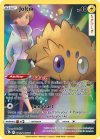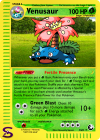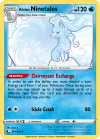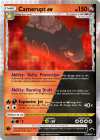Well, you’ve clearly put a lot of thought into this card — any time somebody writes up a multi-paragraph essay to go with their entry, that much is plain to see.

It’s a very legitimate strategy to draw design inspiration from existing formats and try to imagine how your card would fit into them, and DP-UL is a fertile format for inspiration if there ever was one.
The card does a few things, and it does them pretty well. It accelerates Energy if you hit it with the right type of attack, it can conserve those Energy and move them to another Pokémon later with Geothermal Outflow, and it tanks hard. 140 HP is nothing to laugh at in a format where most attacks do 60-80 damage, and most [R] and [W] Pokémon won’t want to attack into it at all. So you’ve got a bulky wall that can also provide the support a deck needs to run smoothly, if you power it up with the right input. You just need to think about what the ideal input might be. Actually, thinking about it, it’s not so different from a steam engine after all.
You mention
Whiscash MT in your post, but I’m not sure it’s necessarily the right partner for this card — do you really want to be attacking with Magnitude all game? Coalossal can power up Lugia LEGEND, Giratina LV.X, Regigigas LV.X; the format’s most untenable attack costs, and it can even play them like a legendary toolbox of sorts. With Whiscash, you’re limiting yourself to an effect that isn’t really that much better than Abomasnow SF’s Snow Play, and requires much more maintenance to run. I think the ideal partner for Coalossal is something like a Water-type Donphan Prime, or perhaps a more reliable
Psyduck TM — something that doesn’t require as much setup itself, but lets you efficiently use Coalossal to set up something much bigger.
Anyway, on the rest of the card: Geothermal Outflow isn’t an especially new attack in terms of its effect, but it fits well here. If you don’t have the Pokémon in play that you want to accelerate to, you can accelerate to Coalossal and move the Energy off later. Making Coalossal into a consistently viable target for its own Ability is a nice design touch, and one that will no doubt help the card in plenty of gameplay situations.
On the aesthetics, I like that you’re taking a step back from the all-out bells and whistles you’ve sometimes employed in the past. Still, the card should be clean and consistent, which here basically means not mixing holosheets. Real cards don’t do this because they only have room thickness-wise for one holosheet; two on the same card would be a logistical nightmare. So if you want to holo up both the border and the text area of the card, the realistic approach is to make them the same sheet.
I’ll also give you the same illustration advice I gave Kaleidophoenix in their result, which is that a lot of traditional (non-digital) art styles are hard to make work as illustrations on cards. It’s not outside the realm of possibility, but as a minimum, you want the Pokémon to be the focal point of the image — large, unmissable, taking up most of the frame and screaming “I’m here, look at me!” The sleeping Coalossal here … well, it might just be that it’s not a pose I’m used to seeing Coalossal in, but at first I thought it was just a big pile of rocks. It took me a moment to recognize that it was the Pokémon. If the frame focuses more narrowly on the subject of the illustration, with Coalossal being both the center of the image and the biggest thing in it, it’s harder for the viewer to make that mistake.
Overall it’s not bad work. I like how much thought you put into the design and gameplay potential, as well as the inspiration you took from a real format for it. The effects are genuinely good from a balancing perspective; I have no issues with the card’s believability, and with the right partner(s), it could be quite fun to play. The main things holding you back are all pretty minor — improvements to aesthetics, a more creative attack, etc. — and for the most part easily fixed. It’s an interesting card, and I wish you the best of luck playtesting it!
(As an aside, DP-UL was a format that was pretty light on Energy acceleration overall. The decks that did the best were the ones that could cram every trick in the format into a 60-card list, and high Energy counts on the order necessary for most Energy acceleration decks ran pretty antithetical to that approach. For a deck like your Coalossal/Whiscash concept, which hopes to attach at least 4 Energy a turn while cycling the old ones from the discard pile back into the deck, you need to devote a pretty substantial amount of deck space to your Energy count, and I think the deck’s matchups would probably suffer for it. Furthermore, note that Regice LA’s Regi Move isn’t technically a gust effect — your opponent chooses the Pokémon to switch, and they’re extremely unlikely to choose Nidoqueen. So that strategy for dealing with Maternal Comfort unfortunately doesn’t work. End aside.)
Wording errors:
- The first part of Steam Engine should read “If this Pokémon is damaged by an attack from a [R] or [W] Pokémon,” per cards like Rugged Helmet. The “by an attack” part is important. [-2 points]
Fonts and Placement errors:
- The “100” damage numerals aren’t right; they look like a default font like Myriad Pro. Omnium convention (as well as Classic-through-ex-era convention) is to put them in Gill Sans. Note the difference in the “1”. [-1 point]
Creativity/Originality: 12/15
(Steam Engine is a neat effect with good gameplay potential. Geothermal Outflow is a little less exciting just because it’s a very familiar effect, but it too has good gameplay potential, so the card is solidly well designed as a whole.)
Believability/Playability: 15/15
(No major balancing concerns. Steam Engine could be quite underpowered if you weren’t able to activate it with your own Pokémon, but the synergy makes it workable. The numbers on the attack and HP feel reasonable, too.)
Wording: 8/10
(One error; otherwise looks good..)
Fonts and Placement: 4/5
(Don’t forget to keep an eye on those default fonts.)
Aesthetics: 2/5
(Not bad, but not stand-out. Coalossal taking a backseat in its own artwork hurts you a little here, as does the mixing of the holosheets.)
Total: 41/50











